Willow
design by Michael
Brown
MY
50TH BRITHDAY PRESENT
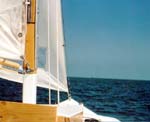 The
name of the boat is "Willow". Designing it all
started a year ago, when I turned 49 years old. With no
boat to take sailing in the Winter, I needed to buy or build
one. Having only a 4 cylinder pick-up for towing, the boat
had to be light enough for that size truck. This made the
choice between building and buying a lot easier. Building
a light boat that is big enough to sleep on and sail around
to different areas in would be the best. I also wanted it
have draft of less than 2 feet, so that it would be easy
to launch. All this made the decision for me. Designing
it was something I learned to do in 1985, so it was about
time I used this education. Other than the designs I had
to draw for school, I hadn’t yet used what I know. The
name of the boat is "Willow". Designing it all
started a year ago, when I turned 49 years old. With no
boat to take sailing in the Winter, I needed to buy or build
one. Having only a 4 cylinder pick-up for towing, the boat
had to be light enough for that size truck. This made the
choice between building and buying a lot easier. Building
a light boat that is big enough to sleep on and sail around
to different areas in would be the best. I also wanted it
have draft of less than 2 feet, so that it would be easy
to launch. All this made the decision for me. Designing
it was something I learned to do in 1985, so it was about
time I used this education. Other than the designs I had
to draw for school, I hadn’t yet used what I know.
 What
I came up with was a 20' long, 7.5' wide boat with about
2000 lbs. maximum weight that I could tow a long distance.
I did a small drawing so that I could do all the calculations
on the rough design. This was also how I got the look I
wanted the boat to have. It turned out to have all the right
numbers and the shape that I was looking for. So I started
doing the line drawings, and the table of offsets. This
all took about two weeks of working at night to complete.
Of course this was the line drawing only, no sail plan,
no construction plan, and no plan for the house or cabin.
I did know what I wanted the boat to look like, so I didn’t
need a plan for that. What
I came up with was a 20' long, 7.5' wide boat with about
2000 lbs. maximum weight that I could tow a long distance.
I did a small drawing so that I could do all the calculations
on the rough design. This was also how I got the look I
wanted the boat to have. It turned out to have all the right
numbers and the shape that I was looking for. So I started
doing the line drawings, and the table of offsets. This
all took about two weeks of working at night to complete.
Of course this was the line drawing only, no sail plan,
no construction plan, and no plan for the house or cabin.
I did know what I wanted the boat to look like, so I didn’t
need a plan for that.
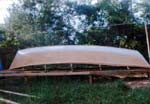 The
design is a modified dory, v-bottom, full keel, with an
enlarged transom. The house has 48" of headroom, and
is 8' long and 5' at the widest. The sail plan is under
sized for the length of the boat. With everything being
made of wood, I felt right at home building all of it. The
design is a modified dory, v-bottom, full keel, with an
enlarged transom. The house has 48" of headroom, and
is 8' long and 5' at the widest. The sail plan is under
sized for the length of the boat. With everything being
made of wood, I felt right at home building all of it.
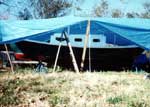 The
biggest challenge was deciding on the thickness and type
of plywood and wood to use. The weight of the plywood was
more important than thickness. Reducing the thickness from
1/2" to 3/8" doesn’t seem like a lot of
weight being saved with one sheet, but it is if you add
the weight savings from 10 sheets. I didn’t need the
hardness of white oak for the frames. I needed a wood that
was soft, easy to work with, and still was close to the
weight of oak, so I chose yellow pine. For cost reasons,
I decided to use AC ext. plywood over marine grade. The
biggest challenge was deciding on the thickness and type
of plywood and wood to use. The weight of the plywood was
more important than thickness. Reducing the thickness from
1/2" to 3/8" doesn’t seem like a lot of
weight being saved with one sheet, but it is if you add
the weight savings from 10 sheets. I didn’t need the
hardness of white oak for the frames. I needed a wood that
was soft, easy to work with, and still was close to the
weight of oak, so I chose yellow pine. For cost reasons,
I decided to use AC ext. plywood over marine grade.
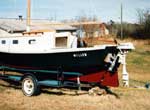 Once
I decided on the plywood size , I could loft the boat full
size, which was done in only two nights of work. It wasn’t
warm at that time of the year either. After the lofting
was done, it was time to build the frames for the hull.
The hull was built upside down with the keel laminated on.
It turned out to be light enough for me to turn the hull
right side up by myself. That should tell you how light
the boat was at this point. Once
I decided on the plywood size , I could loft the boat full
size, which was done in only two nights of work. It wasn’t
warm at that time of the year either. After the lofting
was done, it was time to build the frames for the hull.
The hull was built upside down with the keel laminated on.
It turned out to be light enough for me to turn the hull
right side up by myself. That should tell you how light
the boat was at this point.
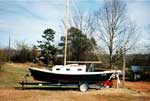 This
is the point at which I had no more plans to work from.
All the rest of the boat came from what I wanted it to look
like. This is not as hard as it may seem, if you know how
to construct the rest. I have the line drawings with the
table of offsets on it, if anyone wants to build this boat.
The cost for the drawings is only $15.00. You can build
the hull, and then make the rest of the boat look the way
you want. This
is the point at which I had no more plans to work from.
All the rest of the boat came from what I wanted it to look
like. This is not as hard as it may seem, if you know how
to construct the rest. I have the line drawings with the
table of offsets on it, if anyone wants to build this boat.
The cost for the drawings is only $15.00. You can build
the hull, and then make the rest of the boat look the way
you want.
Michael
Brown
|

